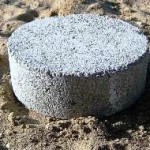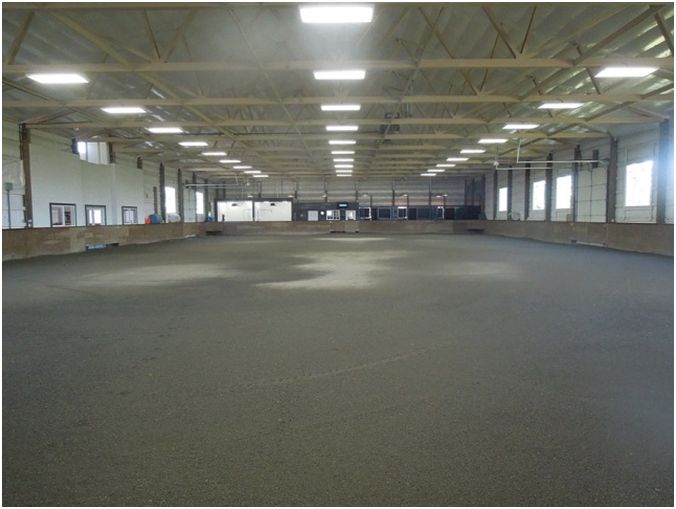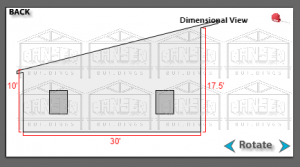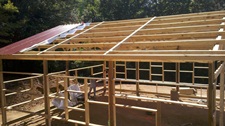I know none of us has ever experienced this condition, but we all know of someone who has had the hurling issue, often after a period of personal discussion with some of the friends of George Thorogood.
In this instance, I’m not thinking either of the example above, or the tasty oatmeal raisin cookies my grandma made for us when we were kids. I am making specific reference to the pre-cast chunks of concrete usually four to six inches in thickness and 12 to 18 inches in diameter which are sold or provided for footings in pole buildings.
The basic concept is to throw concrete cookies in the bottom of the augered holes and place the building columns directly upon them. The general idea is for the cookies to support the weight of the building, to prevent settling.
My recommendation – RUN, DO NOT WALK, away from this as a design solution.
Why?
They are a failure looking for a place to happen.
Let’s look at what a footing is supposed to do. The dead weight of the building PLUS all imposed live loads must be distributed to the soils beneath the building. Sounds pretty simple, eh?

To begin with, the International Building Codes require concrete footings to be a minimum of six inches in thickness. This eliminates immediately any concrete cookies which are less than this thickness (most of them).
Examine a fairly small example – a 30’ wide building with columns spaced every eight feet. The actual weight of the building (dead load) will vary greatly depending upon the materials used. Steel roofing and siding will be lighter than shingles and wood sidings. For the sake of this example, we will use a fairly light 10 psf (pounds per square foot) building weight. The Code specifies a minimum roof live load of 20 psf. This means each footing must carry the weight of one-half of the width (15 feet) times the column spacing (8 feet) times 30 psf. Doing the math, 3600 pounds.
In many parts of the country soil bearing pressures are as little as 1500 or even 1000 psf. Basically – the easier it is to dig, the lower the capacity of the soil to support a vertical load.
For every foot of depth below grade, the soil capacity is increased by 20%. Other than with 1000 psf soils, for every foot of width over one foot, the capacity also gets a 20% increase.
With 1500 psf soil, and the bottom of the footing four feet below grade, a 12 inch footing will support 2700 pounds per square foot.
A 12 inch diameter footing covers 0.785 square feet, a 16 inch 1.4, 18 inch 1.77, 24 inch 3.14.
The 16 inch footing would support exactly the 3600 pounds from the example above. However – lots of places in the country have snow loads (which the footings must support) and many buildings are wider than 30 feet, or have columns placed over eight feet apart.
Trying a 40 foot span, with a 40 psf roof snow load, same eight foot column spacing, would mean resisting an 8000 pound load! With 1500 psf soils, even a two foot diameter footing would be inadequate.
In most cases, the use of concrete cookies as footing pads proves to be both inadequate and a waste of good money. To insure a building won’t settle, (from inadequate footings), look for a plan produced by a registered design professional who is proficient in post frame building design. He/She will have the history and training to design your building to withstand the loads…which begins with the foundation.










In the deep south, I have built numerous large decks using concrete cookies every six feet o.c. or so using pressure treated 2×6 joists and 2×4 surface lumber with 2×4 and 2×6 legs total height of about twelve inches above the ground. This is a DIY approach that anyone can handle if they are not afraid of drilling pilot holes and the rust resistant screws and it has resulted in decks that wow everyone who sees them. twelve years later the first is in fine shape and cost a fraction of what your approach would require which pretty much eliminates having a deck if you don’t have much more money than the American majority (an underclass compared to 1960) can afford, so you would have them do without the deck and all the enjoyment it provides unless they are willing funnel big bucks into an engineers pocket for something so easily achieved without it. How about taking a broader view and telling people how to do something useful (with cautions) without the big dollar approach you are currently suggesting?
Joseph ~ Constructing a building system is much different than that of a deck. Our approach really is not as expensive as you make it sound. Simply drill your post holes and depending on the size and weight of the structure the amount of concrete can vary typically from hole diameters 18″-36″ wide while filling the hole with 18″-24″ of concrete. For an average building, 2-3 yards of concrete at most are required while providing a much stronger design that is capable of resisting downward pressure and uplifting forces. Comparing this to a typical precast 24″ wide by 6″ thick concrete cookie found at a large big box store for $33 each you will actually put money in your pocket using our method of footing. Each of our building kits are engineer designed to meet your local design criteria. For a nominal fee you can purchase engineer sealed plans if required. With building kits sold in all 50 states it shows just how affordable our pole building designs are for the average household.
I Googled concrete cookies and found your page. I’m an architect and I’ve never heard of them, for good reason. I have a client that wants a portable shed, because the area he is in allows “portable” sheds to not get permits if they are 120 square feet or less and not permanently attached. I called their building department and sure enough this was the case. I asked if we could bury some 4x4s and cookie-like footings down to frost and her was response was “I’m going to pretend you didn’t say that” to which I replied, “I’m asking because I don’t want my client’s shed to become a projectile in a tornado (we DO have those in the Midwest, yes even in southwest Michigan). The code person’s response was “I wasn’t around when some of these strange codes were passed. Most people just prop these up onto concrete cookies.” Okay, so you’re around now, maybe some revamping is in order? So my email to my client with the design will come with my concern, in writing and copied to his contractor and to the building official.
And it is not even an old “strange” code being passed – it is the mentality of “we have always done it this way, so we will continue to do it this way”.
As you are aware, every three years a new edition of The Code is adopted, often with some serious changes in the ways climactic loads are looked at and calculated. Why? Because failures occurred based upon the previously “best known science”.
In much of Michigan (and many other states) post frame buildings meeting (or supposedly meeting) certain requirements are totally exempt from the permit and plan review process. And they keep falling down and sadly these practices will probably not change until fatalities begin to occur as a result of them.
One thing that you didn’t take into account, cookies are made with higher psi concrete. Does that change the factors?
The strength of the concrete will not reduce the diameter required to adequately distribute the load. It is a factor of weight to be support and area.
The new 2015 NFBA Post-Frame Building Design Manual, Second Edition does provide the following, “In accordance with ANSI/ASAE EP486.2, the actual thickness of unreinforced (plain) precast footing that is placed on a flat, compacted base shall not be less than 4 inch. Load-induced forces may dictate a thicker footing.”
Keep in mind, while ANSI/ASAE EP486.2 is cited in the Code, the Code itself specifies footings to be a minimum of six inches in thickness, so there exists the possibility for creation of a debate with plan’s examiners and building inspectors.
No. Because concrete strength is not the limiting factor. Soil bearing pressure is. Normal weight concrete with 3000psi strength is already ~144x stronger than 3000psf capacity soil. Increasing concrete strength doesn’t change the soil bearing properties.
You obviously have an agenda. Your post makes a ton of assumptions and really doesn’t even begin to provide a fair analysis of putting precast concrete in the hole. So it may not work in all conditions – fine. Telling people to RUN is disingenuous without knowing about their building size, soil conditions, and tons of other parameters. This has worked for a long time and will continue to work for a long time because it’s a viable method to support posts in many situations. Thousands of pole barns are standing with this type of footing configuration and that most certainly is statistically relevant. If it was as bad as you say, there would be more empirical data to validate your claims. The more articles I read, the more apparent it becomes that you’re pushing the Hansen agenda.
Anthony ~
Yes, I have an agenda – Code conforming structures which perform structurally. Period. End of story.
My article certainly does not rule out the use of concrete cookies, however it does point out, in most cases, they are inadequate to support the loads imposed.
When it comes to structural analysis, the burden of proof is upon the RDP (engineer or architect) to show the design they propose meets sound engineering practice. In the event you are able to run the math to prove your assertions I would more than appreciate being educated.
I have a 12×16 shed with attic sitting on treated 4×4 post that were dropped in holes dug in the sand with nothing else under them.
I back-filled holes with sand only. I was 20 years old at the time, inexperienced and $$ was very tight.
The post are 4′ on center and 5′ deep. 26 years later thru the high MN temp. cycles, it’s still their and looks great.
(If I had it over again, I think I would have poured concrete piers though)
Jeff ~ It sounds like you have been very, very lucky to not have your shed either settle or uplift out of the holes. Some folks have those blessings and win at the lottery – most of us, we would have seen some challenges over time.
You mention above that the soil bearing capacity is increased by both the depth and width of the footing? I have not found this info in anything else that I have looked at. Does this appear in a code or something else that I can reference? Thanks.
Jonathan ~ Check out Section 1806 of the IBC (International Building Code). Chapter 5 of the NFBA (National Frame Building Association) Post-Frame Building Design Manual Second Edition delves into footing and foundation design extensively and would be an ideal resource as well.
Thank you. I looked it up in the IBC and noticed that they only mention the increase in terms of the lateral bearing pressure, not the vertical bearing pressure. However I looked it up in Post-Frame Building Design Manual (which references the Uniform Building Code) and found exactly what you mentioned about the 20% increase per foot of depth and width. Thanks again.
Okay, I see what is the solution. I am not an engineer/architech or other, but a previous life builder. Attach the poles to the poured foundation and wallha you have the strength of the rebar connection along with the weight of the floor to prevent settling and uplift. Thoughts?
There are engineered brackets which are designed to be incorporated into poured concrete foundations and can provide adequate uplift resistance in most cases.
In my opion your trying to get customers (and in your words) “run” from companies trying to sell their kits with the “footing cookies” from their company to yours. Now this again is just my opion, but I feel as a consumer and diyer, that this article would have been many times better with not just saying “cookies are bad ours is better” by giving more solid proof and possibly other options for people who are looking to build a post frame building or are resarching the step they are on. (just my assumtion why people would end up here) I get it your a company trying to better your business. But bashing other without solid proof or maybe adding options to the cookie would have been a better approach. At least to me.
Maybe you should reread the article?
Nowhere in it do I recommend doing business with Hansen Pole Buildings, nor do I bash any other post frame builder or provider. What I do bash is an inadequately designed system which is all too frequently specified. As for solid proof – I have provided some examples which include the weights which much be supported.
The real point of the article is if one is going to invest in a new post frame building – make certain it comes along with engineer sealed plans which are specific to YOUR particular building at YOUR particular site.
The best possible building is only going to be as good as the foundation it rests upon. Engineering is not a COST or EXPENSE, it is an investment in the longevity of your building and the safety of those who utilize it.
As a builder & electrical contractor my question is far simpler….WHY would anyone want to do something twice? You will be sooner or later and we are not taking about any uplift issues. If you are questioning something most likely you need to take another route. A “cookie” are you kidding me? Just common sense people , look at the weight you are carrying. Some of these footings are like having two cars on top of each other pressing down on a cookie. Is that with or without the chocolate chips? Everything starts with a good foundation. There are companies out there that will sell precast footing/piers 24 sq base round or square vertical rise with 5000 psi and loaded with rebar . cost is around 95.00 each this would be the minimum I would use. Then Simpson connectors from the concrete to the post.
The worst offenders are builders – looking for fast, cheap and easy 🙁
One thing you forgot to mention about “The Code” (I assume you are referring to the International Building Code or International Residential Code) is that if you interpret the IRC literally, post frame buildings aren’t permitted. Per Section R403.1, “All exterior walls shall be supported on continuous solid or fully grouted masonry or concrete footings, crushed stone footings, wood foundations, or other approved structural systems that shall be of sufficient design to accommodate all loads according to Section R301 and to transmit the resulting loads to the soil…. The key word in that very long sentence is CONTINUOUS. While post frame buildings may be approved under Section R104.11, they are not prescriptively accepted in the IRC. In Ohio, the State of Ohio actually inserted a section that deals prescriptively with post frame construction. I’m not sure why the WFBA doesn’t submit a proposal for the I-Codes that provides for prescriptive design parameters.
The issue with a prescriptive Code (IRC) is they are extremely limiting in their scope. Due to their very nature, they have to be broad enough so as to overkill to the worst case design. How limiting is the IRC? Trusses cannot be used to span over 36′ and buildings cannot be over 60 feet as measured perpendicular to the span of the trusses. Maximum snow loads are limited to Pg = 70 (roof snow loads of 49 psf). There is no prescriptive provision for a bearing wall height of over 12 feet.
If prescriptive wording was done under IRC parameters, it would cover only post frame buildings up to 36′ x 60′ x 12′ and would be non-applicable to area of higher snow or wind loads. The solution is to require all post frame buildings to be built using building specific plans sealed by an RDP (Registered Design Professional).
I think you just nailed it in that last response, and it makes a strong case for post frame in that the IRC is not written to result in efficient structures or use of material. Every building is unique and requires its own unique engineering solution. I think the high cost of housing in this country is in part due to the unnecessary expense of building precipitated by the IRC. The amount of concrete and wood blissfully dumped into a small single family home using the prescriptive code is ridiculous. An engineered foundation on properly evaluated soil not only prevents building failure, but also serves to ensure the owner that appropriate amount of resources are allocated to achieve the desired outcome. Good design supported by sound engineering practices will provide the most useful, durable, and enjoyable buildings, as well as the lightest environmental footprint. The average cost to build a small building – think granny flat – where I live is over $340.00 per SF if you follow the IRC. Start with a post frame, engineer the structure, work with a competent architect to get an efficient envelope and you will be far ahead of any money saved by eliminating design and engineering from the budget and instead relying on the IRC.
Hello. I am planning to build some structures and my thought is to put the cookie into the packed hole for the 6×6 to sit on until we pour the concrete around the post. My thinking is that if the post is just sitting in the hole in the dirt it might take up water easier. I plan to use a sleeve on the posts.
Provided the cookie has an adequate diameter and thickness it might be fine. The engineer who seals your structural building plans can best address your individual situation.
Concrete cookies, or pre-cast concrete footings, may seem like a convenient solution for pole buildings, but they are often inadequate and problematic. Typically four to six inches thick and 12 to 18 inches in diameter, these footings fail to meet International Building Codes requiring a minimum six-inch thickness and sufficient load distribution. For a reliable foundation, consult a registered design professional experienced in post-frame building design to ensure proper footing and load support.